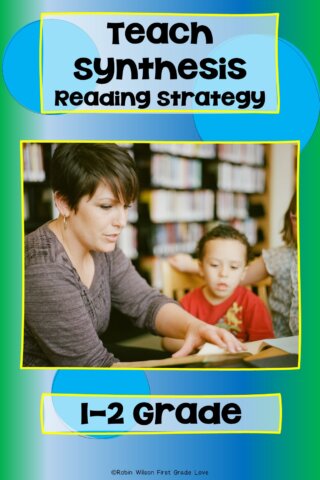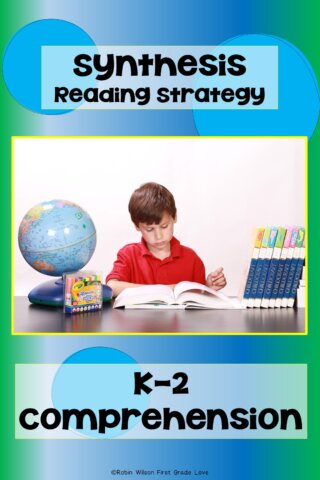Hey you! The Synthesis Reading Strategy will help your young readers understand how a turn of events can help them to change their mind. But many teachers and parents have questions!
Can a 6 year old synthesize, or even 7-8 year old? And why should I even teach this concept to such a young child?
Synthesis is the ability to change your mind given a set of of circumstances that aren’t what you thought in the beginning. We all synthesize daily, and even your toddlers can synthesize. They don’t know that is what it is called, but if they think they are going to daycare and you pull up to grandmas house, they begin to jump up and down and squeal with excitement. They realized they weren’t going where they thought they were going and changed their mind about where they were going. Whoo, that was a lot of ‘going.’ But they synthesized!
To synthesize is to be able to change your mind about a prediction or conclusion you have come to. Even the youngest readers can understand when a book ends differently than what they expected. That’s simply it. If you ask young students how a book will end halfway through reading, then again as you go along in the book, if they have changed their mind or their prediction, they have synthesized.
Children and adults do this all the time without thinking about it. But when you teach it, you help students to recognize when they change their opinion of the outcome or prediction.
Can I teach a 6-8 Year old to Synthesize? Really?
So, the questions is, “Can I teach 6-7-8 year olds to synthesize? Yes! Should I even think about teaching them to synthesize? Yes!!
But how, when they sometimes can’t even read? Through read alouds.
Teach them as you are reading aloud to them. You can point out where the turn of events happen in a story and reveal to them as you go the new details that allow them to change their mind. This brings reading books alive, and makes them more fun! You will enjoy it as a teacher or homeschool parent too!
How to Teach Synthesis Reading Strategy
- First, introduce the book and begin reading.
- As you are reading, allow students and young children to make a prediction about how it will turn out.
- When you notice a turn of events in a story, point it out. Give out all the information you can. Remember, they need to be led on this pathway of discovery.
- When the outcome is different than expected, point out they have synthesized!
- See if your students can see this in other texts you read.
- Scroll down to see a list of books to get your started.
- Click here for resources to help you get started. Synthesis Reading Strategy
When children start to realize these changes can happen, it becomes a fun way to look for clues, and changes of events.
How to Get Started Teaching Synthesis
To get started, introduce a book, such as “The Giving Tree,” by Shel Silverstein. Many of us already have this gem in our classrooms or on our bookshelves. As you read and get to the place where the boy is swinging on the branches, ask your students or child to share with a partner or with you how the tree will be in the end? As you read, continue to stop and ask if they have changed their mind. In the end point out that you have synthesized if you changed your mind in how you think this story changed.
Lesson plan: Synthesis Reading Strategy
Synthesizing: Taking background knowledge and applying to context clues to come to a new understanding. You can change your mind about your prediction.
Lesson Plan:
Before the Lesson

Write “Synthesize” or “Synthesis Reading Strategy” at the top of an anchor chart. For young students, such as first or second graders, chunk it up into smaller parts to help them segment the syllables in the word. Do not worry if they are not fluent with the title. They can get the idea and still refer to the chart. Write the definition in simple terms on your anchor chart.
“Synthesize: When you read a book and you change your mind about your prediction in the end.”
Explain: When you are reading a book and make a prediction, but then there is a turn of events. At that point you begin to change your mind about your prediction. That is when you synthesize.
Start with Story Telling
This morning, I came to school and was thinking that our day would start just like every day. We would come in, get our backpacks put away, eat our breakfast (Yes, we eat in our room), and get started on our morning work. But then I saw an email that today was picture day! We had to hurry, eat, get lined up, and head to the gym for pictures. I had to change my thinking about how our morning would go. I had to change my mind about what we were going to be doing. (You will have to adjust the story to make it your own. You may have to make it up about your morning at home if your day is going as planned. Haha!)
Tell them, we can also change our minds or adjust our thinking about how a book is going to go or how it will end as we get more information.
Students understand in story form. Story telling is a great strategy to get many concepts.
During the Lesson
Read: I Want My Hat Back, by Jon Klassen
Stop on the page the bear says, “I HAVE SEEN MY HAT.”
Ask the students, “Where do you think he saw his hat?” Allow students to answer. Someone may say the rabbit had it on. Don’t give it away. Ask 2-3 students where they think the hat is? Allow for answers. Don’t share your opinion.
Then, read up to the page that the bear runs back to the rabbit and accuses him of stealing his hat. Turn the page and read, “Excuse me, have you seen a rabbit wearing a hat?” Ask what happened to rabbit? Then read the rest of the page. Allow for discussion.
After the Lesson
Ask: Also, this is a great place for turn and talk. If you have a printable, students can draw what they are thinking with a partner.
1.Did we change our minds about anything in this book?
2.What did you think happened to rabbit at first?
3.What do you think actually happened to rabbit?
4.How did you change your mind in this story?
Explain: This is called synthesizing, when we change our minds about a prediction we made.
Tip: You can use this with most books that have surprise endings.
Make a color copy of the book you use and glue it to your anchor chart. If you read more than one book, you can add them to your anchor chart.
Books to Teach Synthesis Reading Strategy
Books that are good to teach with Synthesis in Reading:

1. ‘The Dot’ by Peter H. Reynolds
2. ‘The Very Hungry Caterpillar’ by Eric Carle
3. ‘Where the Wild Things Are’ by Maurice Sendak
4. ‘Harold and the Purple Crayon’ by Crockett Johnson
5. ‘The Giving Tree’ by Shel Silverstein
6. ‘If You Give a Mouse a Cookie’ by Laura Numeroff
7. ‘Green Eggs and Ham’ by Dr. Seuss
8. ‘The Tale of Peter Rabbit’ by Beatrix Potter
9. ‘Goodnight Moon’ by Margaret Wise Brown
10. ‘Brown Bear, Brown Bear, What Do You See?’
by Bill Martin Jr. and Eric Carle
11. ‘The Day the Crayons Quit’ by Drew Daywalt
12. ‘The Rainbow Fish’ by Marcus Pfister
13. ‘The Polar Express’ by Chris Van Allsburg
14. ‘The Snowy Day’ by Ezra Jack Keats
15. ‘Corduroy’ by Don Freeman
Let’s get technical about Synthesis in Reading
Haven’t you ever wished you could quickly get to the heart of a reading passage and better remember the ideas afterwards? Teaching the synthesis reading to young students is one way to do just that. With the synthesis reading strategy, students learn to break down a text and identify the main ideas, relate those ideas to each other and then create a concise summary. Studies show that this technique can help students develop their understanding of a text, better remember its content and even improve their writing skills. With this article, you’ll learn why synthesis reading is so powerful, how to apply it with young students, and how to create activities that will make learning the skill enjoyable. With these tips, you’ll be equipped to help your child become a more powerful and efficient reader.
Synthesis in Reading is Overlooked in Young Readers
In a world of overflowing information and competing demands, the ability to quickly and accurately synthesize written material is an invaluable skill—especially for young readers. Despite the clear benefits, synthesis reading—the process of recognizing patterns, relationships, and meanings between various pieces of text—is often an overlooked tool in early education. Fortunately, with the right strategies, parents and teachers can help kids of any age develop this invaluable skill. Drawing from research from top educational institutions, we’ll also share insights on why synthesis reading is so important—and how it can help young students better understand the world around them.
Synthesis reading is a great strategy for young readers to practice when reading a book. It involves the reader connecting the ideas and concepts they’ve been exposed to, thereby helping them form a deeper understanding of the text. Synthesis readers look for patterns in the text, pay attention to overarching themes, and draw meaningful conclusions that they can use to make their own meaningful insights. This strategy can help young readers develop a better understanding of the text and aid in the development of critical thinking skills.
There’s more? Yup!
To read about more reading strategies, click these links below.
- Making Reading Comprehension Simple with 7 Strategies
- Text to Text Connections
- Text to Self Connections
- Text to World Connection
- Background Knowledge Reading Comprehension
For more resources for first grade click here! Robin Wilson First Grade Love


